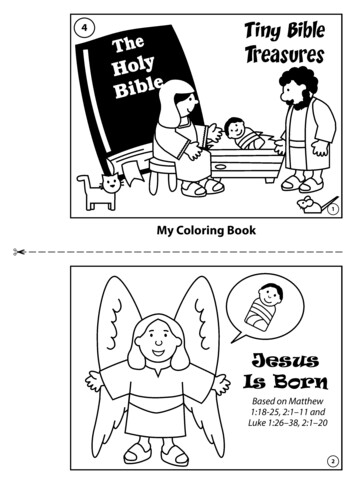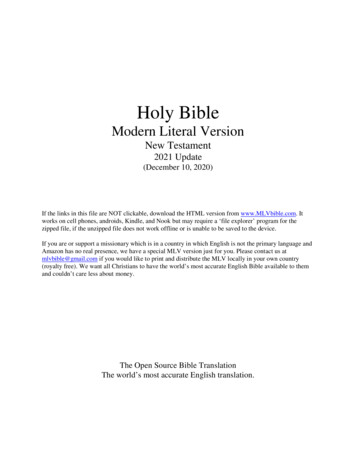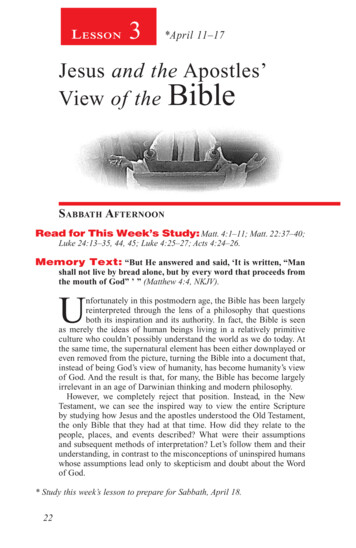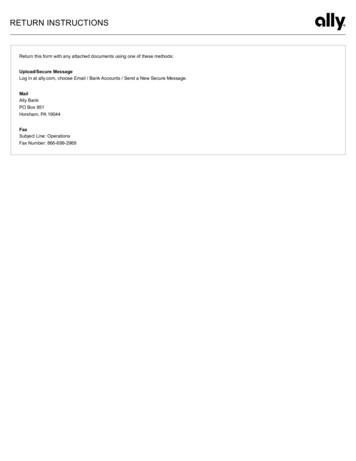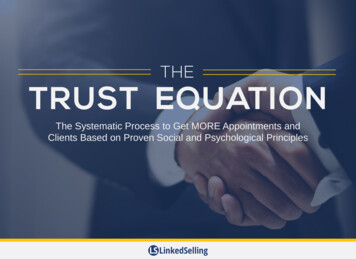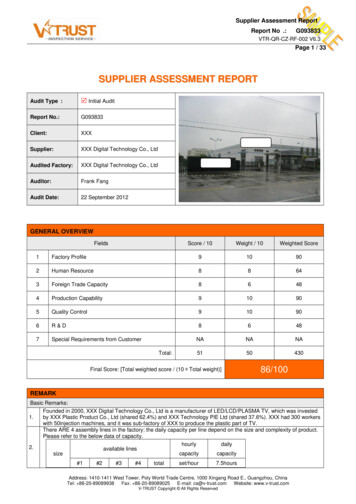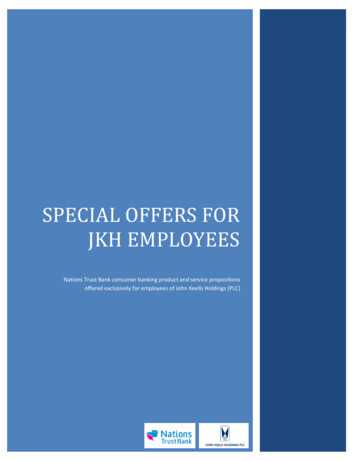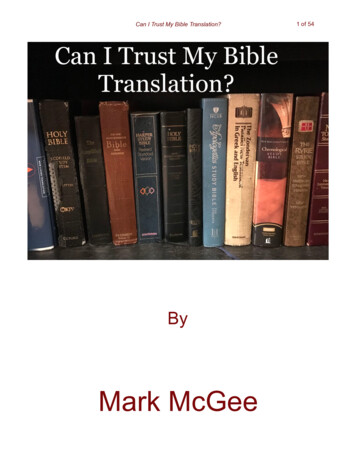
Transcription
Can I Trust My Bible Translation?ByMark McGee1 of 54
Can I Trust My Bible Translation?2 of 54
Can I Trust My Bible Translation?3 of 54Part OnePage 5Part TwoPage 15Part ThreePage 24Part FourPage 36Part FivePage 50
Can I Trust My Bible Translation?4 of 54
Can I Trust My Bible Translation?5 of 54Part OneMany years ago we wrote a series titled Can I Trust The Bible? andpublished the 30-part series in six eBooks. You’ll find them listed at the topof our Free Apologetics eBooks webpage.Our conclusion to the question, Can I Trust The Bible?, is a resoundingYES! However, that yes is based on the particular view of the Holy Bible ascontaining 66 Books in two divisions: Old and New Testaments. We did notfind that the apocryphal books passed the test of Inspiration by the HolySpirit. You can read Part 4 of our study to see more about why we reachedthat conclusion.What we would like to do now is ask and answer another importantquestion: Can I Trust My Bible Translation? We will be looking specificallyat English translations in this series and some of the more popularparaphrases.
Can I Trust My Bible Translation?6 of 54How Many English Translations?The American Bible Society estimates “the number of printed Englishtranslations and paraphrases of the Bible, whether complete or not, isabout 900.” (ABS, 2009)I’ve seen other estimates that are half thatnumber (approx. 450), but we get the point. There are a lot of Englishtranslations and paraphrases of the Bible.What’s the difference between a translation and a paraphrase?TranslationA ‘translation’ is “the activity or process of changing the words of onelanguage into the words in another language that have the same meaning.”(Cambridge Dictionary)The word ‘changing’ should give us some pause as we consider translatingthe Bible from its three original languages (Hebrew, Aramaic, Greek) intoEnglish – or any other language for that matter. How can we know thatwhen we read an English translation of the Bible we are getting a trueunderstanding of the original language? How can we be sure that we’re‘reading’ the same thing in English that the original readers thousands ofyears ago read in Hebrew, Aramaic or Greek?
Can I Trust My Bible Translation?7 of 54The purpose of a translator should be to “accurately render the meaning ofbiblical texts from their original languages—Hebrew and Aramaic for theOld Testament, and Greek for the New Testament—into a ‘receptorlanguage.’ Scholars and committees of scholars use the latest knowledgeof ancient manuscripts to express accurately what the original authors ofScripture meant.” (What About Bible Translations? BibleGateway.com)Some translators do that through a ‘word-for-word’ process (FormalEquivalence). Other translators do that through a ‘thought-for-thought’process (Dynamic Equivalence). More on that in a few minutes.ParaphraseA ‘paraphrase’ is “to repeat something written or spoken using differentwords, esp. in a shorter and simpler form to make the meaningclearer.” (Cambridge Dictionary)Again we see the idea of changing the original words to a ‘shorter andsimpler form.’ That should also give us pause since we’re talking aboutsomeone shortening and simplifying the Bible to supposedly ‘make themeaning clearer.’Says who? Who are these ‘translators’ and ‘paraphrasers’? Can we trustthem to be accurate and unbiased in their work?
Can I Trust My Bible Translation?8 of 54TranslatorsEvery ‘translation’ of the Bible (or portions of the Bible) has at least one‘translator.’For example, Martin Luther translated the Bible from Hebrew and Greekinto German. Luther used Erasmus’ 1519 edition of the Greek NewTestament (Textus Receptus) for his translation of the New Testament. Thatwas somewhat novel since the Church had used the Latin version of theBible for centuries prior to Luther’s Bible. Even the German version of theBible used during that time had come from the Latin version. However,Latin was not one of the original languages of the Bible, so Luther wiselyused Greek for the New Testament and Hebrew for the Old Testament.Luther established a ‘committee’ of theologians to help him translate theOld Testament from Hebrew. He even consulted Jewish rabbis to makesure of the accuracy of his German translation.ParaphrasersEvery ‘paraphrase’ of the Bible (or portions of the Bible) has at least one‘paraphraser.’One example is The Living Bible paraphrase by Kenneth Taylor. It waspublished the same year I became a Christian (1971). Instead of using theoriginal languages to ‘translate’ the Bible, Taylor used an English translation(1901 American Standard Version) to ‘paraphrase’ God’s Word. Taylor said
Can I Trust My Bible Translation?9 of 54the paraphrase came from answering his children’s questions about Bibleverses. He paraphrased the Bible to help them understand the meaningand thought that would be something to share with other families.Taylor later worked with a team of Hebrew and Greek scholars to reviseThe Living Bible and turn the former ‘paraphrase’ into a ‘translation.’ (1996,Holy Bible, New Living Translation)Translation TypesTranslators use two primary methods when translating the Bible –1. Formal Equivalence2. Dynamic EquivalenceFormal EquivalenceThis is a word-for-word translation and is sometimes called a ‘literal’translation. Translators look for a word in English that communicates thesame idea as the Hebrew, Aramaic or Greek. The English Standard Version(ESV) is an example of a recent ‘word-for-word’ translation.
Can I Trust My Bible Translation?10 of 54Dynamic EquivalenceThis is a thought-for-thought translation and is sometimes called ‘functional’equivalence. Translators attempt to capture the ‘meaning’ of the originallanguage. The New International Version (NIV) is an example of asomewhat recent ‘thought-for-thought’ translation.Optimal EquivalenceOne other option for translators is to try to balance between word-for-wordand thought-for-thought. The Holman Christian Standard Bible (HCSB) isan example of that type of translation.Early English TranslationsTranslations of portions of the Bible into Old English began as early as the7th century AD. Some of the earliest names of Old English translatorsinclude Venerable Bede, Caedmon, Aldhelm, and King Alfred the Great.Translations of portions of the Bible into Middle English began as early asthe 11th century AD. Some of the earliest names of Middle Englishtranslators include Orm of Lincolnshire, Richard Rolle, and John Wycliffe.
Can I Trust My Bible Translation?11 of 54Wycliffe’s BibleWycliffe translated the Bible from the Latin Vulgate into Middle Englishduring the latter part of the 14th century AD. It is believed that Wycliffe didsome of the translation for the New Testament and oversaw othertranslators for the rest of the Bible. Though a great thing for Englishspeaking people, the Catholic Church opposed Wycliffe’s translation.A Roman Catholic Synod at Oxford banned Wycliffe’s Bible in 1408 AD andissued an edict against any unauthorized translation of the Bible intoEnglish. The Council of Constance (1415 AD) declared Wycliffe to be aheretic. The Church did its best to destroy all of the copies of Wycliffe’sBible, but more than 200 copies or revisions are believed to have survived.Most are in museums and libraries.One of Wycliffe’s primary beliefs after studying and teaching the Bible wasthat the Bible is the ultimate authority for Christians and not the Pope. PopeMartin V ordered Wycliffe’s body exhumed and burned in 1428 AD.Wycliffe’s opposition to papal authority explains why.Tyndale’s BibleWilliam Tyndale was born at the end of the 15th century (beginning of EarlyModern English period) and trained in both Greek and Hebrew. He wantedto translate the Bible into English, but the 1408 edict was still in force. Hetraveled to Germany and learned Hebrew from Jewish rabbis. It was inGermany that Tyndale translated the Bible into English from Hebrew and
Can I Trust My Bible Translation?12 of 54Greek. He completed the New Testament translation in 1525 AD. He laterrevised the translation using Erasmus’ third edition of the Greek NewTestament. It became the first English New Testament version translatedfrom the Greek.The Coverdale BibleMyles Coverdale was an assistant of William Tyndale. He used Tyndale’sOld Testament (what Tyndale finished before his death), Martin Luther’sGerman Bible, and some Latin texts to complete the entire Bible in English.The Coverdale Bible became the first complete Bible to be printed inEnglish (1535 AD). King Henry VIII gave Coverdale permission to translateand print.Coverdale also moved the Apocryphal books from being ‘inside’ the OldTestament to being in an ‘appendix’ position at the end of the OldTestament.Matthew’s BibleMatthew’s Bible (written by John Rogers whose pen name was ThomasMatthew) was first seen in 1537 AD. Matthew combined Tyndale’s NewTestament with Tyndale’s and Coverdale’s Old Testament. Matthew alsoadded about two-thousand notes to the Bible.
Can I Trust My Bible Translation?13 of 54The Great BibleKing Henry VIII wanted a Bible that would be larger than Matthew’s Bibleand used in every church in England. Myles Coverdale, at the request ofLord Cromwell, prepared what became known as The Great Bible (basedon its physical size). Coverdale included much from Matthew’s Bible,except for Matthew’s notes. Coverdale also finished translating the OldTestament.The Geneva BibleMary Tudor became Queen of England in 1553 and returned the country toCatholicism. English Bibles were burned and many Protestants werepersecuted and killed. Some scholars fled to Geneva, Switzerland andproduced an English translation of the New Testament from Greek in 1557(using Stephanus’ fourth edition of the Greek NT). The Old Testamenttranslation from Hebrew along with a revised New Testament waspublished in 1560 as The Geneva Bible. It was the Bible used byShakespeare and the Puritans.The Bishop’s BibleThe Bishop’s Bible of 1568 was a revision of Tyndale’s Bible, produced bybishops. It was not very popular (final printing in 1606 AD), but it becamethe primary Bible the King James translators were directed to use in theirtranslation.
Can I Trust My Bible Translation?14 of 54
Can I Trust My Bible Translation?15 of 54Part TwoEarly Modern English TranslationsWe looked at the earliest English translations of the Bible and portions ofthe Bible in the first part of our series. That included Old English, MiddleEnglish and Early Modern English translations. Some of the translationscame from the Latin Vulgate. Other translations came from Greek andHebrew copies of Scripture.The Early Modern English period began in the late 15th century AD andcontinued until the early 18th century. It coincides with the Tudor and Stuartdynasties in England.We’ve already looked at Wycliffe’s Bible, Tyndale’s Bible, The CoverdaleBible, Matthew’s Bible, The Great Bible, The Geneva Bible and TheBishop’s Bible. We turn next to what may be the greatest of the EarlyModern English Bibles, the King James Bible.
Can I Trust My Bible Translation?16 of 54The King James BibleJames Charles Stuart was born in 1566 to Mary, Queen of Scots. He wasalso the great-great-grandson of Henry VII, King of England and Lord ofIreland. James succeeded to the Scottish throne when he was just 13months old and gained control of his government in 1583 (several regentsgoverned for James while he was a child). He succeeded Queen ElizabethI, the last of the Tudors, since she died childless. That gave King Jamesrule over Scotland, England and Ireland until his death in 1625.King James met with a conference of church leaders in 1604 AD and askedthat the English Bible be revised because some of the existing translations“were corrupt and not answerable to the truth of theoriginal.” (Britannica.com) James approved a list of 54 ‘revisers’ who wereorganized into six groups. The archbishop of Canterbury oversaw thetranslation process. They published the new Bible in 1611 AD.The groups used extant English-language translations along with a partialTyndale translation and Jewish commentaries to help them in translatingOld and New Testament. The Greek text they used is known as ‘TextusReceptus’ (Latin for ‘received text’). The translators relied on three Greekscholars in making the New Testament translation: Desiderius Erasmus,Theodore Beza and Robert Estienne (Latin name – Stephanus). Each manused a small number of available Greek manuscripts to build their copy ofthe Greek New Testament, which the King James Bible translators used assources for their work.
Can I Trust My Bible Translation?17 of 54[You can read the translators introduction to the 1611 version by clickinghere.]The King James Bible included the Apocrypha in the 1611 printing in aspecial section between the Old and New Testament. Several apocryphalbooks were part of the King James Bible until 1885 AD (almost 275 years).The King James Bible has also gone through many spelling, punctuationand wording changes since the original 1611 version.The King James Bible, also called the King James Version (KJV) andAuthorized Version (AV) became the standard English Bible from themiddle of the 17th century to the early part of the 20th century. It continuesto be the choice of many English-speaking Christians to this day.The KJV is a Formal Equivalence translation (word-for-word).Late Modern English TranslationsThe term ‘Late Modern English’ (also known as ‘Modern English’) isbelieved to have come about because of the Industrial Revolution and therise of the British Empire in the 18th and 19th centuries. Colonialism had ahuge impact on the English language as did the ‘New World’ that becamethe United States of America. Thomas Jefferson is quoted as writing this ina letter in 1813 – “The new circumstances under which we are placed callfor new words, new phrases, and for the transfer of old words to newobjects. An American dialect will therefore be formed”. (The History ofEnglish)
Can I Trust My Bible Translation?18 of 54The transition from Early Modern English to Late Modern English also hadan impact on Bible translations.English Revised VersionTranslators in England attempted to revise the King James Version in thelate 19th century. It was called the English Revised Version (ERV).Translators referenced The New Testament in the Original Greek byWestcott and Hort and The Greek New Testament by Samuel Tregelles.The New Testament portion of the ERV was published in 1881 and titled –The New Testament of our Lord and Saviour Jesus Christ, Translated out ofthe Greek: Being the Version Set Forth A.D. 1611, Compared with the MostAncient Authorities and Revised, A.D. 1881. (Oxford: Oxford UniversityPress, 1881). The Old Testament portion of the ERV was published in1885. The entire ERV was titled – The Holy Bible containing the Old andNew Testaments translated out of the original tongues : being the versionset forth A.D. 1611 compared with the most ancient authorities and revised.Oxford: University Press, 1885. 4 vols. The Apocrypha was added to the1885 version.The American Revision (also known as American Standard Version – ASV)was published in 1901 and titled – The Holy Bible, Containing the Old andNew Testaments, Translated out of the Original Tongues, Being the VersionSet Forth A.D. 1611, Compared with the Most Ancient Authorities andRevised A.D. 1881-1885, Newly Edited by the American Revision
Can I Trust My Bible Translation?19 of 54Committee A.D. 1901, Standard Edition. New York: Thomas Nelson &Sons, 1901.The RSV and ASV are Formal Equivalence translations (word-for-word).The American Standard Version became the basis of four later revisions: Amplified Bible, 1965 Revised Standard Version, 1971 Recovery Version, 1999 World English Bible, 2000The ASV was also the basis for Kenneth Taylor’s ‘Living Bible’ paraphrase(1971).The Amplified BibleI became a Christian out of atheism, so my parents asked their pastor whatBible he would recommend for me to read. He recommended they get meThe Amplified Bible and they did less than a month after I became aChristian. It was my first Bible (post-atheism) and helped me immensely asI studied to understand God and His Word.I still use The Amplified Bible in my study from Greek and Hebrew. Theversion I have was copyrighted in 1965 and is now called The AmplifiedBible Classic Edition (AMPC). The Lockman Foundation published TheAmplified Gospel of John in 1954. Lockman and Zondervan published The
Can I Trust My Bible Translation?20 of 54Amplified New Testament in 1958 and The Amplified Old Testament in twoparts (1962 and 1964). The Amplified Bible was first published in 1965.A committee of qualified Hebrew and Greek scholars worked together toprepare a translation that includes explanatory alternate readings andamplifications along with word-for-word emphasis. The AMPC used multipleEnglish word equivalents to each key Hebrew and Greek word to clarifyand amplify the meaning of the original text.“The AMPC is based on the American Standard Version of 1901,Rudolph Kittel’s Biblia Hebraica, the Greek text of Westcott and Hort,and the 23rd edition of the Nestle Greek New Testament as well as thebest Hebrew and Greek lexicons available at the time. Cognatelanguages, the Dead Sea Scrolls, and other Greek works were alsoconsulted. The Septuagint and other versions were compared forinterpretation of textual differences. In completing the AMPC, translatorsmade a determined effort to keep, as far as possible, the familiarwording of the earlier versions, and especially the feeling of the ancientBook.” Lockman Foundation, Version InformationI used The Amplified Bible along with the King James Version for manyyears in personal reading, study and teaching. I continue to use the 1965version along with the updated 1985 AMPC and the 2015 AMP versionswhen comparing word definitions and meaning with original languages(Hebrew, Aramaic, Koine Greek).
Can I Trust My Bible Translation?21 of 54New King James VersionThomas Nelson Publishers commissioned a large group of Bible scholars,church leaders and lay Christians to update the vocabulary and grammar ofthe King James Version (KJV). The 130 translators spent seven yearstranslating from Hebrew, Aramaic and Greek texts – Hebrew – Biblia Hebraica (with comparisons to the Ben Hayyimedition of the Mikraot Gedolot) Greek – Textus ReceptusThe New King James Version (NKJV) came out in three phases –1. New Testament, 19792. New Testament and Psalms, 19803. Complete Bible, 1982The NKJV is a Formal Equivalence translation (word-for-word). **[The Preface to the New King James Version calls it a ‘Complete’Equivalence Translation – “This principle of complete equivalence seeks topreserve all of the information in the text, while presenting it in good literaryform.”]
Can I Trust My Bible Translation?22 of 54English Standard VersionOne of the more recent Bible translations in English that is also a FormalEquivalence translation (word-for-word) is the English Standard Version(ESV). The publishers (Crossway) state that the ESV “stands in the classicmainstream of English Bible translations over the past half-millennium. Thefountainhead of that stream was William Tyndale’s New Testament of 1526;marking its course were the King James Version of 1611 (KJV), the EnglishRevised Version of 1885 (RV), the American Standard Version of 1901(ASV), and the Revised Standard Version of 1952 and 1971 (RSV).”The ESV publishing team was made up of more than 100 people, including14 members of a translation oversight committee, more than 50 translationreview scholars, and more than 50 members of an advisory committee. TheESV translation is based on the Masoretic text found in Biblia HebraicaStuttgarensia for the Old Testament and on the UBS/Nestle-Aland 28thedition for the New Testament.You can read the Preface to the English Standard Version by clicking here.
Can I Trust My Bible Translation?23 of 54
Can I Trust My Bible Translation?24 of 54Part ThreeWhich translation or paraphrase of the Bible do you use most often? Canyou trust it? Can you trust that the words you read are accurate to thewords and meaning from the original languages of the Bible?That is the question we are asking in this series of studies and it is animportant question. Satan tested Jesus in the wilderness and said, “If Youare the Son of God, command that these stones become bread.” Jesusresponded by saying, “It is written, ‘Man shall not live by bread alone, butby every word that proceeds from the mouth of God.” (Matthew 4:3-4)Jesus quoted Moses from Deuteronomy 8:3 –“So He humbled you, allowed you to hunger, and fed you with mannawhich you did not know nor did your fathers know, that He mightmake you know that man shall not live by bread alone; but man livesby every word that proceeds from the mouth of the Lord.”If God wants us to ‘live’ by His ‘every’ Word, then we must be sure thatwhat we’re calling God’s Word is accurate to the original texts. Much is atstake for us and the people we influence.
Can I Trust My Bible Translation?25 of 54Dynamic Equivalence TranslationsIn the last part of our study, we looked at the history of Modern Englishversions of the Bible that are Formal Equivalence translations (word-forword). We will look at Dynamic Equivalence translations (thought-forthought) in this part of our series.Dynamic Equivalence is sometimes called ‘functional equivalence’.Translators attempt to capture the ‘meaning’ of the original language. TheNew International Version (NIV) is one example of a somewhat recent‘thought-for-thought’ translation.New International VersionThe idea for the new translation of the Bible began with Howard Long, anengineer from Seattle. He loved the King James Version but found using itto share the Gospel with people difficult because of the difference inEnglish words from the 17th to 20th centuries. That led to a ten-year queston his part for a new Bible translation. Long’s denomination, the ChristianReformed Church, and the National Association of Evangelicals supportedLong’s vision and the process began in 1965.The New York Bible Society sponsored the project. Scores of scholars froma variety of Christian denominations worked in groups for several years totranslate the Bible from the original languages. The New Testament waspublished in 1973 and the full Bible in 1978. Revisions were published in1984 and 2011.
Can I Trust My Bible Translation?26 of 54“The first concern of the translators has been the accuracy of thetranslation and its fidelity to the thought of the Biblical writers. They haveweighed the significance of the lexical and grammatical details of theHebrew, Aramaic, and Greek texts. At the same time, they have strivenfor more than a word-for-word translation. Because thought patterns andsyntax differ from language to language, faithful communication of themeaning of the writers of the Bible demands frequent modifications insentence structure and constant regard for the contextual meaning ofwords.” Preface to the New International Version, 1984New Living TranslationThe New Living Translation began as an effort to revise The Living Bibleparaphrase, but evolved into a new English translation from the originallanguages. The first edition was published in 1996 with revisions in 2004,2007, 2013 and 2015.“The translators of the New Living Translation set out to render themessage of the original texts of Scripture into clear, contemporaryEnglish. As they did so, they kept the concerns of both formalequivalence and dynamic-equivalence in mind. On the one hand, theytranslated as simply and literally as possible when that approach yieldedan accurate, clear, and natural English text. Many words and phraseswere rendered literally and consistently into English, preservingessential literary and rhetorical devices, ancient metaphors, and wordchoices that give structure to the text and provide echoes of meaningfrom one passage to the next.
Can I Trust My Bible Translation?27 of 54On the other hand, the translators rendered the message moredynamically when the literal rendering was hard to understand, wasmisleading, or yielded archaic or foreign wording. They clarified difficultmetaphors and terms to aid in the reader’s understanding. Thetranslators first struggled with the meaning of the words and phrases inthe ancient context; then they rendered the message into clear, naturalEnglish. Their goal was to be both faithful to the ancient texts andeminently readable. The result is a translation that is both exegeticallyaccurate and idiomatically powerful.” New Living Translation, TyndaleOther Bible translations that would be considered Dynamic Equivalence are– Amplified Bible (1965) Confraternity Bible (1969) Good News Bible (1966, 2001) Modern Language Bible (1969) New American Bible (1970) New World Translation of the Holy Scriptures (1961) Today’s New International Version (2005)
Can I Trust My Bible Translation?28 of 54Optimal EquivalenceOptimal Equivalence is a blending of both Formal Equivalence andDynamic Equivalence. One example is the Holman Christian StandardBible.“The CSB follows a translation philosophy called ‘optimal equivalence.’The term conveys a commitment to both “formal equivalence” (whichrecognizes the importance of the form of the original language text—thatis, the words used and the grammatical and rhetorical structures) and‘functional equivalence’ (which recognizes the importance of conveyingthe original message and intent in natural English readily understood bymodern readers).” Christian Standard Bible, Holman Bible Publishers
Can I Trust My Bible Translation?29 of 54Comparing TranslationsOne of the best ways to compare translations is by selecting Scriptureportions from the different types. We’ll compare the NKJV (FormalEquivalence) with the NIV (Dynamic Equivalence) and CSB (OptimalEquivalence) to see how each one translates well-known Bible verses.John 3:16NKJV – “For God so loved the world that He gave His only begottenSon, that whoever believes in Him should not perish but haveeverlasting life.”NIV – “For God so loved the world that he gave his one and only Son,that whoever believes in him shall not perish but have eternal life.”CSB – “For God loved the world in this way: He gave His One andOnly Son, so that everyone who believes in Him will not perish buthave eternal life.”Psalm 23:1NKJV – “The Lord is my shepherd; I shall not want.”NIV – “The Lord is my shepherd, I lack nothing.”CSB – “The Lord is my shepherd; there is nothing I lack.”
Can I Trust My Bible Translation?30 of 54John 1:1-5NKJV – “In the beginning was the Word, and the Word was with God,and the Word was God. He was in the beginning with God. All thingswere made through Him, and without Him nothing was made that wasmade. In Him was life, and the life was the light of men. And the lightshines in the darkness, and the darkness did not comprehend it.”NIV – “In the beginning was the Word, and the Word was with God,and the Word was God. He was with God in the beginning. Throughhim all things were made; without him nothing was made that hasbeen made. In him was life, and that life was the light of all mankind.The light shines in the darkness, and the darkness has not overcomeit.”CSB – “In the beginning was the Word, and the Word was with God,and the Word was God. He was with God in the beginning. All thingswere created through him, and apart from him not one thing wascreated that has been created. In him was life, and that life was thelight of men. That light shines in the darkness, and yet the darknessdid not overcome it.”
Can I Trust My Bible Translation?31 of 54Isaiah 53:1-3NKJV – “Who has believed our report? And to whom has the arm ofthe Lord been revealed? For He shall grow up before Him as a tenderplant, And as a root out of dry ground. He has no form orcomeliness; And when we see Him, There is no beauty that weshould desire Him. He is despised and rejected by men, A Man ofsorrows and acquainted with grief. And we hid, as it were, our facesfrom Him; He was despised, and we did not esteem Him.”NIV – “Who has believed our message and to whom has the arm ofthe Lord been revealed? He grew up before him like a tendershoot, and like a root out of dry ground. He had no beauty or majestyto attract us to him, nothing in his appearance that we should desirehim. He was despised and rejected by mankind, a man of suffering,and familiar with pain. Like one from whom people hide their faces hewas despised, and we held him in low esteem.”CSB – “Who has believed what we have heard? And to whom has thearm of the Lord been revealed? He grew up before him like a youngplant and like a root out of dry ground. He didn’t have an impressiveform or majesty that we should look at him, no appearance that weshould desire him. He was despised and rejected by men, a man ofsuffering who knew what sickness was. He was like someone peopleturned away from; he was despised, and we didn’t value him.
Can I Trust My Bible Translation?32 of 54Romans 8:37-39NKJV – “Yet in all these things we are more than conquerors throughHim who loved us. For I am persuaded that neither death nor life, norangels nor principalities nor powers, nor things present nor things tocome, nor height nor depth, nor any other created thing, shall be ableto separate us from the love of God which is in Christ Jesus ourLord.”NIV – “No, in all these things we are more than conquerors throughhim who loved us. For I am convinced that neither death nor life,neither angels nor demons, neither the present nor the future, nor anypowers, neither height nor depth, nor anything else in all creation, willbe able to separate us from the love of God that is in Christ Jesus ourLord.”CSB – “No, in all these things we are more than victorious throughHim who loved us. For I am persuaded that not even death orlife, angels or rulers, things present o
published in 1560 as The Geneva Bible. It was the Bible used by Shakespeare and the Puritans. The Bishop’s Bible The Bishop’s Bible of 1568 was a revision of Tyndale’s Bible, produced by bishops. It was not very popular (final printing in 1606 AD), but it became the primary Bible the




